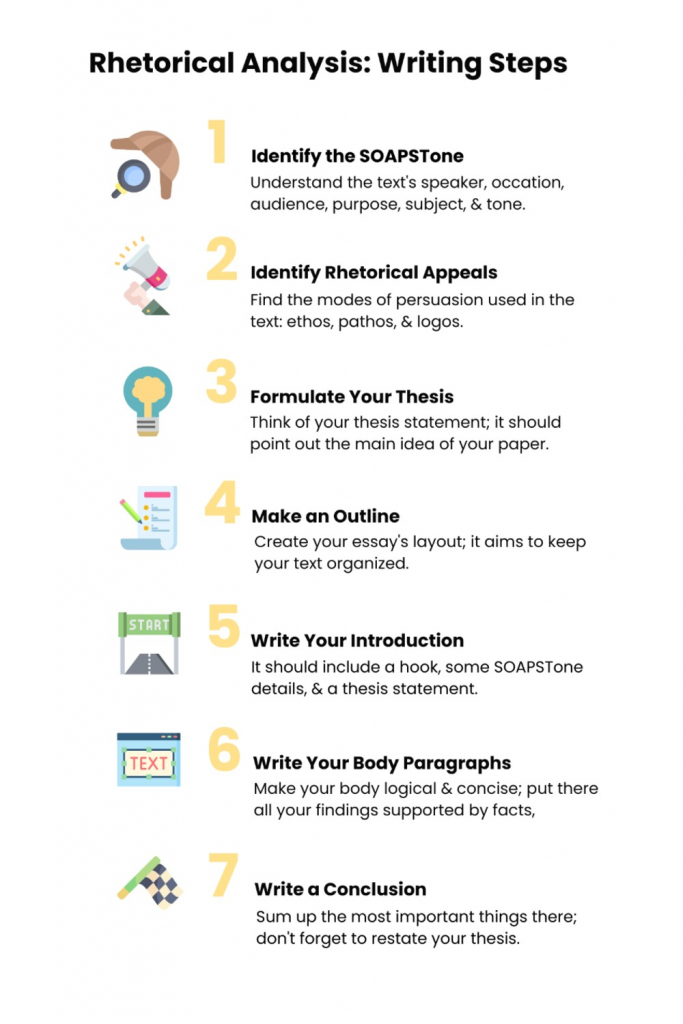If you are assigned to write a rhetorical analysis essay, you have one significant advantage. You can choose a text from an almost infinite number of resources. The most important thing is that you analyze the statement addressed to an audience. The task of a rhetorical analysis essay is to identify the speaker’s main objectives. However, it is also crucial to work through the rhetorical strategies the speaker uses.
In this article by Custom-Writing.org experts, you will get to know the SOAPSTone and rhetorical appeals. This is included in our seven-step guide on how to write a rhetorical analysis essay. You’ll find out the essential tips on formatting and formulating the thesis statement. There are also a rhetorical essay outline and examples at the end for your reference!
❓ What Is a Rhetorical Analysis Essay?
In a rhetorical analysis essay, you have to divide a text into parts and explain whether they work together or not. It is quite different from a usual literary analysis. The task is to find out how successful the speaker is at reaching their objective.
How to Write a Rhetorical Analysis Essay: Main Steps
There are several steps you should follow to hit the highest score for your essay. First, you should work with SOAPSTone and rhetorical appeals. Then, you should proceed with basic tasks, such as writing a thesis statement and outline. When you have these done, it’s time to put it all together into the three main parts of the essay.

Step #1: Identify the SOAPSTone of the Text
SOAPSTone is a very handy tool to help you understand the text you are dealing with. The following questions allow you to gather all the information you will need for future analysis.

Step #2: Identify Rhetorical Appeals Used in the Text
Rhetorical appeals are also known as “modes of persuasion” and include ethos, pathos, and logos. They can be understood as tools for making others believe a particular point of view. Some of the most potent examples can be found in advertisements.
Ethos
Ethos is related to the speaker’s credibility. Mentioning some impressive qualifications or years of practice reassures the reader of the speaker’s reliability and trustworthiness. It helps to persuade the audience.
For example, a doctor might write an article about the surgery success rate after 30 years of practicing in the field. Demonstrating one’s expertise like this is an excellent example of ethos.
Pathos
Pathos is all about emotions. Evoking deep feelings in the listeners is a powerful tool, which helps the speaker convince them. The range of emotions varies from love, admiration, and sympathy to anger and hate. Whenever the response from the audience aligns with what the speaker is expecting, it is a win. Usually, it is achieved by using provocative language.
For instance, a mayoral candidate shouts out into the crowd that hundreds of people could lose their jobs if they don’t do something. The speaker aims to make the audience feel resentful of the current situation and sympathetic to a new plan. This way, they are more likely to vote for this candidate since they feel passionate about the promises.
Logos
Emotions are not always enough to convince someone to follow you, are they? Therefore, the last crucial mode is logos. Logos is responsible for logic. Appealing to reason is mostly used in an academic environment, but it’s not uncommon in other fields. The speaker could use reliable data, facts, and evidence to convince the audience.
Using numbers is always a good idea. For example, during the presentation, the speaker can include some graphs and percentages: “Last year, we finished 23% of projects ahead of schedule, saving over two million dollars for our customers.”
Step #3: Formulate Your Thesis Statement
Remember that your thesis statement is considered to be the front page of your paper. When successfully composed, it points out the main idea of your essay. Therefore, it has to be as clear and specific as possible.
You want to include everything you found out about the chosen text in this single sentence. If you didn’t skip the first two steps, it shouldn’t be a problem! A decent thesis statement would look like this:
Example:
“In her article, the writer mentions her expertise and up-to-date statistics, and appeals to the readers’ pity to convince them of the necessity of regular yearly check-ups for disease prevention.”
Don’t worry if you still can’t come up with anything decent. try using a rhetorical analysis thesis generator that will give you some ideas of what direction you should take in your writing.
Step #4: Create Your Rhetorical Analysis Essay Outline
Even though keeping your essay organized is not your most important task, it is undoubtedly helpful! If you don’t want to forget anything and save yourself quite a lot of time, follow our advice and write an outline. This can be especially helpful if you mostly use visual memory.
Introduction, main body, and conclusion create the basic layout of any essay. The main body of the paper includes at least three paragraphs. The rhetorical analysis essay outline also fits this rule.
Carefully go through all the notes you’ve made and mark the main points you want to include in your essay. Think about the evidence you have to support them. Along with the thesis statement, write it all down in a format of a list. When you are done with it, you may use it as a cheat sheet during the next steps of the writing process.
Now, you’re all set up and ready to begin writing your essay!
Step #5: Write Your Rhetorical Analysis Essay Introduction
There are several things you need to consider when writing an introduction:
- If it’s not your school assignment, let the reader know that it’s a rhetorical analysis.
- Come up with a hook to interest the reader.
- Don’t forget to mention the text or speech you’re analyzing. You can also drop a few facts about it.
- Think of the SOAPSTone details that matter and include them here as well. You don’t have to mention all of the parts, just the ones that make sense to you.
- At the end of the introduction, write your thesis statement. It brings more clarity to this part of the essay.
Step #6: Write Your Body Paragraphs
As usual, this is where you put all your findings and support them with some facts. Don’t forget that there should be at least three body paragraphs. Since it fits the number of rhetorical appeals, you can go ahead and write about ethos, pathos, and logos. Another way of organizing the paragraphs is to present the text’s details chronologically, meaning from beginning to end. In this case, whatever text or speech you chose, it was probably well-prepared, so it helps your analysis look coherent.
It doesn’t matter which option you prefer, but make sure you provide enough support for your arguments. The most effective way to make it work is to use quotes. Also, stick to using the third-person so that you don’t break the rules of academic writing.
You can see how your main points can be organized most effectively in the rhetorical analysis essay sample at the end of the article.
Step #7: Write Your Rhetorical Analysis Essay Conclusion
The purpose of the conclusion is to sum up the most important findings of your analysis. You need to include your thesis statement here as well, but not word-for-word. Aim to paraphrase it and make it seem more sophisticated. This can be achieved by using new terminology. Maybe there is something the readers now understand from your essay that they couldn’t have before.
Then, in the form of a summary, briefly mention the main ideas that support your thesis. You don’t have to be a professional summary typer, just get your idea across in a concise manner. You might add a few words about the importance of your analysis as well. If you think that this issue is worth further research, write that down too.
👀 Rhetorical Analysis Essay: Examples
Below you’ll find an essay aiming to analyze On Women’s Right to Vote by Susan B. Anthony – a speech regarded as one of the best in American history. In this rhetorical analysis essay example, you can see how to put everything together by following the seven-step guide above. Here, the main body is divided into three paragraphs presenting one rhetorical appeal each.
Here are some other essay examples for you to check out.
- Obama Speech: Rhetorical Analysis and Evaluation
- “Get Out” Movie’s Rhetorical Analysis
- Susan B. Anthony’s Speech: Rhetorical Analysis
- Rhetorical Analysis of John F. Kennedy’s Inaugural Address
- Steve Jobs’ Commencement: Rhetorical Analysis
- Blogs on Euthanasia: Rhetorical Analysis
Rhetorical Analysis Essay Topics
- A rhetorical analysis of one of Hallmark’s commercials.
- Steve Jobs’ speech at Stanford University in 2005: rhetorical analysis.
- The use of rhetorical devices in Gary Shteyngart’s Only Disconnect.
- Rhetorical strategies used in horror film Us by Jordan Peele.
- Analyze Hamlet’s monologues in W. Shakespeare’s The Tragedy of Hamlet, Prince of Denmark.
- Discuss how Martin Luther King Jr. uses rhetorical appeals in his Letter from Birmingham Jail.
- Describe the rhetorical devices used in Greta Thunberg’s speech.
- The common rhetorical aspects used in articles of Carolyn Gregoire and Sophie Reeves.
- Examine the rhetoric in Brooks’ Reading Too Much Political News Is Bad for Your Well-Being.
- Analyse the persuasive devices in Google Analytics App.
- Study the application of rhetorical strategies in Beyond Vietnam: A Time to Break Silence by Martin Luther King, Jr.
- Compare the lyrics rhetoric in The Times They Are A-Changing and The Wind of Change.
- Rhetorical analysis for applying critical thinking.
- Describe the rhetorical devices used in Confessions of a Female Chauvinist Sow by Anne Roiphe.
- Examine the persuasive techniques in the Gillette commercial We Believe: The Best Men Can Be.
- Compare the rhetorical schemes of Abraham Lincoln’s Second Inaugural Address and Emily Dickinson’s Success is Counted Sweetest.
- Rhetorical analysis of Media Control by Noam Chomsky.
- Analyse the persuasive devices used in political debates The Issue of Women and Race (2019).
- Rhetorical appeal in Andrew Cadelago’s film Snack Attack.
- Discuss the rhetorical strategies in Hidden Intellectualism by Gerald Graff.
- Analyse the persuasive devices used in Angelina Jolie’s speech on female empowerment.
- Describe the rhetorical appeals applied by Steinbeck in Of Mice and Men to stir up the emotions of the readers.
- Compare the rhetoric of Margaret Fuller and Fredrick Douglass.
- Body by Milk and Moms Demand Action advertising campaigns: rhetorical analysis.
- Describe the use of three appeals in Coors Light Beer ad.
- Discuss the persuasive tactics in the 1950s advertising with Marilyn Monroe.
- Analyze the rhetorical strategies in Aveeno advertisement.
- Examine the efficiency of persuasive devices in the Stop Bullying public campaign.
- The instruments used to persuade the audience in Anti-Drug Abuse public campaign.
- Explore the rhetorical appeals in Julius Caesar by W. Shakespeare.
- Analyze the persuasive strategies of FIFA franchise.
- Rhetoric of The American Scholar by Ralph Waldo Emerson.
- Describe the rhetorical devices that made Pericles’ Funeral Oration one of the world’s most influential speeches.
- Persuasive techniques in American Crisis by Thomas Paine.
- Analyze the rhetorical strategies used by Linda Hogan in Dwellings.
- Explore the modes of persuasion in Narrative of the Life of Frederick Douglas.
- The Myth of the Charioteer: rhetorical analysis.
- Discuss the rhetorical appeals of Pop Can: Popular Culture in Canada.
- The three appeals in Claire Giordano’s Virtual Promise.
- Rhetorical devices in the film Henry V (1944) directed by Laurence Olivier.
- Describe the rhetoric technique used by Michelle Obama in her TED speech.
- Analyze the persuasive tactics in James Q. Wilson’s Just Take Away Their Guns.
- Compare the rhetorical strategies in Moore’s Idiot Nation and Gatto’s Against School.
🔗 References
- What in the world is a rhetorical analysis? – NC State University
- Rhetorical Analysis – Stanford University
- Rhetorical Strategies // Purdue Writing Lab
- Rhetorical Analysis – Writers Workshop (Illinois)
- Rhetorical Analysis – SAGE Research Methods
- Rhetorical Analysis | Department of English | University of Washington
- Doing a Rhetorical Analysis of a Text (CSU)
- Aristotle’s Rhetorical Situation // Purdue Writing Lab
- Ethos, logos, pathos: Strategies of persuasion in social/environmental reports




![How to Write an Argumentative Essay: 101 Guide [+ Examples]](https://custom-writing.org/blog/wp-content/uploads/2021/01/young-writer-taking-notes-284x153.jpg)
![How to Title an Essay: Guide with Creative Examples [2025]](https://custom-writing.org/blog/wp-content/uploads/2021/01/close-up-woman-making-greeting-card-new-year-christmas-2021-friends-family-scrap-booking-diy-writing-letter-with-best-wishes-design-her-homemade-card-holidays-celebration-284x153.jpg)

![How to Write a Good Introduction: Examples & Tips [2025 Upd.]](https://custom-writing.org/blog/wp-content/uploads/2021/01/closeup-shot-woman-working-studying-from-home-with-red-coffee-cup-nearby-284x153.jpg)

![How to Write about a Topic You Lack Interest in [2025]](https://custom-writing.org/blog/wp-content/uploads/2021/01/Frustrated-exhausted-young-woman-blogger-284x153.jpg)

